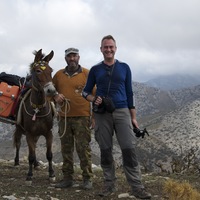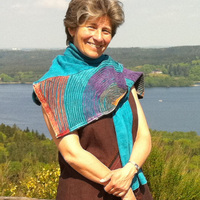
David Hill
I am an archaeologist with a broad range of research fields, from urbanisation and settlement in Western Anatolia in the Early Iron Ages to Antiquity, to the Byzantine Period in the Aegean and Viking and Medieval Scandinavia. I specialise in GIS, landscape and urban topography, with a focus on long term change and adaption.
Address: Oslo, Norway
Address: Oslo, Norway
less
Related Authors
Arne Anderson Stamnes
Norwegian Institute for Cultural Heritage Research
Julian P Cadamarteri
Norwegian Institute for Cultural Heritage Research
Ellen Grav
Norwegian University of Science and Technology
Brit Solli
University of Oslo
Gitte Hansen
University of Bergen
Hans Andersson
Lund University
Ingvild Øye
University of Bergen
InterestsView All (20)









Uploads
Books by David Hill
important goods recorded in the ecclesiastical accounts is butter, commonly used by rural producers to meet their obligations to landowners and to pay taxes. Written records detail how Norwegian butter was also exported into international markets. Parallel to urban development was considerable rural expansion, in particular into the outlands and uplands. Seasonal summer farming grew in scale and pastoral strategies included the intensification of shielings where dairying became the primary activity.
This article will explore the relationship between Veøy and Borgund and the increase in summer farming in the northern part of western Norway. We will argue that butter became an important commodity through the flexibility that transhumance offered as a way of maximizing production
from the landscape, and importantly through the existence of strong political and administrative centres – and later urban population and markets – able to absorb surplus butter production.
26 articles, 432 pages.
N. Burkhardt, Historische Zeitschrift, 2019, Vol.309(1), pp.165-168
P. Maranzana, American Journal of Archaeology, 4/2019, Vol.123(2)
https://www.ajaonline.org/book-review/3856
E. Zanini, Medioevo Greco 19, 2019, 453-455
https://www.academia.edu/41221431/Reviev_of_Efthymios_Rizos_ed._New_Cities_in_Late_Antiquity._Documents_and_Archaeology_Turnhout_2017
M. Sartre, in Syria 96 (2019)
https://journals.openedition.org/syria/8971
Thesis by David Hill
The study noted that ethnic and polis identity were central factors in the creation of states and territories in the Archaic period, but they were also concepts that led to geo-political conservatism. When the second wave of inland urbanisation began, Hellenisation and dynastic policy were the vehicles for eastward spread of towns. This wave of urbanisation can be seen as universal, inclusive and homogenous. There were in addition high levels of conformity and familiarity between the physical and societal structures of the new Hellenistic urban foundations.
Papers by David Hill
of the town were utilising the slope below the walls for cultivation. This information allows us to consider the site as having been permanently inhabited, and not simply a fortified refuge. The survey has concluded that the cultivation terraces were an integrated part of Kastro Apalirou from its earliest phase.
plan of the site, which provided key data for the discussion regarding the function, phasing and nature of the settlement. A total of fifty-four buildings were surveyed, of which thirty-eight were domestic buildings, three larger buildings considered to be institutional, and three cruder ancillary buildings. In addition, the survey identified an estimated further thirty plots whose structures could not be clarified although plot size and location was similar to the domestic houses. Cisterns, constructed with a heavier use of mortar, are more visible and were divided into two classes: five community cisterns that were large and not connected to one particular building, and fifty-two private cisterns that were built as part of a house or building, usually contained within the basement
and accessed internally from the floor above. There were additionally a smaller number of now free-standing external cisterns, which abutted buildings that have since collapsed, and cisterns inserted into gaps within walls and/or connected to Agios Georgios. The high number
of domestic buildings and low number of larger buildings suggestive of institutional use points strongly in the direction of an urban community rather than a fortress. Broadly, two phases were visible; the first representing the layout of streets and construction of the houses, the second representing greater levels of investment in defences, larger buildings and community cisterns and the expansion of the Agios Georgios complex.
https://my.pcloud.com/publink/show?code=XZEbxY7Ztd2tCwyxcHfxaRFH7q3nwYnoviAV
Un étude archéologique récente au Kastro Apalirou , Naxos a documenté une fondation urbaine fortifiée du 7ème siècle . Le modèle traditionnel de d'urbanisation en mer Egée et des Cyclades est de déclin et la rétraction : L'échelle de la ville , son organisation interne et le niveau d'investissement est donc unique pour la région à cette époque . Cet article présente un résumé des premières phases de recherche entrepris par l'Université d'Oslo et ouvre une discussion sur la fondation et le fonction du site.
Will upload introduction page when I have recieve it. Has been published
important goods recorded in the ecclesiastical accounts is butter, commonly used by rural producers to meet their obligations to landowners and to pay taxes. Written records detail how Norwegian butter was also exported into international markets. Parallel to urban development was considerable rural expansion, in particular into the outlands and uplands. Seasonal summer farming grew in scale and pastoral strategies included the intensification of shielings where dairying became the primary activity.
This article will explore the relationship between Veøy and Borgund and the increase in summer farming in the northern part of western Norway. We will argue that butter became an important commodity through the flexibility that transhumance offered as a way of maximizing production
from the landscape, and importantly through the existence of strong political and administrative centres – and later urban population and markets – able to absorb surplus butter production.
26 articles, 432 pages.
N. Burkhardt, Historische Zeitschrift, 2019, Vol.309(1), pp.165-168
P. Maranzana, American Journal of Archaeology, 4/2019, Vol.123(2)
https://www.ajaonline.org/book-review/3856
E. Zanini, Medioevo Greco 19, 2019, 453-455
https://www.academia.edu/41221431/Reviev_of_Efthymios_Rizos_ed._New_Cities_in_Late_Antiquity._Documents_and_Archaeology_Turnhout_2017
M. Sartre, in Syria 96 (2019)
https://journals.openedition.org/syria/8971
The study noted that ethnic and polis identity were central factors in the creation of states and territories in the Archaic period, but they were also concepts that led to geo-political conservatism. When the second wave of inland urbanisation began, Hellenisation and dynastic policy were the vehicles for eastward spread of towns. This wave of urbanisation can be seen as universal, inclusive and homogenous. There were in addition high levels of conformity and familiarity between the physical and societal structures of the new Hellenistic urban foundations.
of the town were utilising the slope below the walls for cultivation. This information allows us to consider the site as having been permanently inhabited, and not simply a fortified refuge. The survey has concluded that the cultivation terraces were an integrated part of Kastro Apalirou from its earliest phase.
plan of the site, which provided key data for the discussion regarding the function, phasing and nature of the settlement. A total of fifty-four buildings were surveyed, of which thirty-eight were domestic buildings, three larger buildings considered to be institutional, and three cruder ancillary buildings. In addition, the survey identified an estimated further thirty plots whose structures could not be clarified although plot size and location was similar to the domestic houses. Cisterns, constructed with a heavier use of mortar, are more visible and were divided into two classes: five community cisterns that were large and not connected to one particular building, and fifty-two private cisterns that were built as part of a house or building, usually contained within the basement
and accessed internally from the floor above. There were additionally a smaller number of now free-standing external cisterns, which abutted buildings that have since collapsed, and cisterns inserted into gaps within walls and/or connected to Agios Georgios. The high number
of domestic buildings and low number of larger buildings suggestive of institutional use points strongly in the direction of an urban community rather than a fortress. Broadly, two phases were visible; the first representing the layout of streets and construction of the houses, the second representing greater levels of investment in defences, larger buildings and community cisterns and the expansion of the Agios Georgios complex.
https://my.pcloud.com/publink/show?code=XZEbxY7Ztd2tCwyxcHfxaRFH7q3nwYnoviAV
Un étude archéologique récente au Kastro Apalirou , Naxos a documenté une fondation urbaine fortifiée du 7ème siècle . Le modèle traditionnel de d'urbanisation en mer Egée et des Cyclades est de déclin et la rétraction : L'échelle de la ville , son organisation interne et le niveau d'investissement est donc unique pour la région à cette époque . Cet article présente un résumé des premières phases de recherche entrepris par l'Université d'Oslo et ouvre une discussion sur la fondation et le fonction du site.
Will upload introduction page when I have recieve it. Has been published
å foreta utgravninger av utvalgte gravbygninger og gravområder for å avdekke nekropolens bruksperioder.
Valget falt på en gruppe med tre bygninger og tre sarkofager i nekropolens øverste del; i tillegg ble det foretatt noen spredte stikkgravninger rundt i gravplassområdet. Dette arbeidet dannet grunnlaget for videre studier, der vi i en sosial sammenheng ønsket å undersøke en bybefolkning i detalj over en lengre periode gjennom studier av gravarkitektur og landskapsoppfatning,
organisasjon, familietilhørighet og entreprenørvirksomhet, rituell handling og praksis, genetiske relasjoner og opphav, paleodemografi, helse og sykdommer, dietter og enkeltpersoners bevegelsesmønstre. For å kunne svare på mange av disse spørsmålene ble det også foretatt bioarkeologiske undersøkelser, som C14-dateringer, osteologi og
DNA- og isotopanalyser. Målet med denne artikkelen er å diskutere hva de foreløpige studiene rundt disse spørsmål kan fortelle oss om liv og død i Hierapolis, sett i en videre lokal og regional kulturkontekst. Gravplassens historie strekker seg fra 1./2. årh. e.Kr. til ca. år 1300,
og fanger opp religionsskiftet i senantikken. Der er derfor naturlig, etter en historisk innledning, å se på hvorledes døden (gjennom gravenes lokalisering, form og innhold) ble behandlet før og etter religionsskiftet, deretter hva skjelettene kan fortelle om livskvalitet og endringer i den
Byzantine Periods
From the mid-seventh century, the Aegean became unstable and the Cyclades were directly threatened by piracy and raiding. Textual and archaeological sources paint a clear picture of settlement movement from the coast and abandonment of sites on smaller islands. Naxos, as the largest island in the archipelago, is mountainous and well-watered in relation to the smaller neighbouring islands. The Naxian response to the crisis was to relocate the political and ecclesiastical capital of the island to a fortified mountain-top site in the interior. In constructing Kastro Apalirou, the builders needed to create new forms of architecture that would allow viable settlement at the waterless site. A domestic house type that used rooftop water harvesting and storage in basement cisterns became a dominant feature of the community. The large elite households of Antiquity were replaced with smaller and more compact domestic units. These developments can be seen as radical and resulted in a sustainable and enduring feature of Cycladic settlement—nucleated hilltop villages. Changes to the settlement pattern elsewhere on the island hint at social fragmentation and dispersal as churches become smaller and more numerous. In this paper, I present new data from recent research and argue that medium-sized islands have a greater ability to react to crisis and challenges compared to more central and mainland regions.